The 2003-04 season was not a suitable encore to the modern ascension of Cornell hockey. Cornell won fewer than 20 games after 25-win and 30-win seasons. Cornell did not earn a berth to the 2004 ECAC Championships at the Times Union Center. The most disheartening part of the 2003-04 season was the playoffs. Cornell hosted Clarkson the 2004 ECAC Tournament. The Golden Knights left Lynah Rink with a victory in the series. The visitors had wrested from hostile Lynah Rink two wins in a three-game series. Cornell had not lost a playoff series at Lynah Rink during the Schafer Era.
Cornell begins each season with the expectation that it will compete for the Whitelaw Cup in March. Cornell fell far from that goal in the 2004 ECAC Tournament. The 2004-05 team felt compelled to ensure that all the progress that had been gained in the previous nine seasons was neither lost nor forgotten.
Mike Knoepfli was tapped to wear the captain's C for the 2004-05 season. The roster he would help Schafer helm included 12 veterans who had helped Cornell win its tenth Whitelaw Cup in 2003. A talented sophomore squad had experienced defeat in its first season. That second-year core included Byron Bitz, Mitch Carefoot, Dan Glover, Kevin McLeod, Mark McCutcheon, Ryan O'Byrne, and Evan Samela. The Big Red reloaded with incoming freshmen Troy Davenport, Doug Krantz, Matt McKeown, Sasha Pokulok, Ryan Sawada, and Topher Scott.
Dave LeNeveu had departed Cornell early after the 2002-03 season. Texan Dave McKee was entrusted with defending Cornell's pipes in his freshman season of 2003-04 season. McKee saw gametime in all of Cornell's games during that season. The first-year goaltender performed well in a starting goal. His defense and he earned a goals-against average of 1.84. McKee managed to produce a save percentage of 0.920 in his first season for Cornell. His performance was one glimmer of hope from a season that seemed mired in pessimism.
Another highlight of the 2003-04 season was the emergence of a freshman of the 2002-03 campaign as a dependable and durable scorer. Matt Moulson emerged as the leading point tallier of the 2003-04 season. A position that he would not relinquish until the completion of his four-year career at Cornell. Moulson totaled 35 points with 18 goals during his sophomore seasons. Four of his 18 goals decided the outcome of the game. This prowess and his burgeoning leadership of the Red squad made the prospects of a Big Red recovery in the 2004-05 season seem more likely.
Various media outlets predicted that Dartmouth would be among the elite in the ECAC during the 2004-05 season. Nearly as many of those followers of the Conference believed that Colgate would be perched atop the league standings with the New-Hampshire Ivy. The Raiders of Colgate had claimed the ECAC's regular-season title during the 2003-04 season. Colgate exited the 2004 ECAC Tournament in a semifinal contest against eventual champion Clarkson. Dartmouth had not returned to the title game of the ECAC Tournament since the insurgent 1979-80 Cornell team upended the Big Red at Boston Garden.
Cornell was given a modicum of respect in most preseason polls. The Big Red, despite its early postseason exit a few months before, was chosen by a small few as the team to beat within the ECAC. The preseason favorites of Colgate and Dartmouth were far from the usual teams suspected to compete for a Whitelaw Cup.
The schedule of the 2004-05 season gave Cornell few out-of-conference contests by which to measure its standing among the nation's elite. The Big Red would host Army, Sacred Heart, and Canisius while the skaters of East Hill would travel to Munn Ice Arena in East Lansing, MI. The field of the Florida College Classic included Boston College, Cornell, Maine, and St. Cloud State.
Cornell opened the regular season with contests against Army and Sacred Heart. Cornell hosted the Atlantic Hockey foes in consecutive nights. The Big Red beat each by identical scores of 7-1. The first contest of Cornell's ECAC slate was against Harvard. The Lynah Faithful would welcome the Crimson on the first weekend of November 2004.
The serenade of "zero offense" that deluged the Harvard Crimson when they visited Lynah Rink captured the flow of the first regular-season meeting between the rivals. Harvard spent most of the contest trapped in its own end. The stereotype of Cornell players as hulking but slow had become ubiquitous among ECAC fans and followers. The size and physicality that had become hallmarks of Cornell teams from the early 2000s kept the faster Cantabs at bay.
Dave McKee was challenged only 17 times in the entire contest. His play in the first conference game of the regular season was stellar. He recorded a shutout that evening. The game was not decided with the teams at even strength. Special teams controlled the evening. Mitch Carefoot and captain Mike Knoepfli connected from behind to in front of the Crimson net for a shorthanded goal. Ryan O’Byrne then shot a beautiful one-timer on one of Cornell's power-play opportunities to give the Big Red an early season 2-1 victory over Harvard.
The next evening Cornell obliterated the Bears of Brown University by a 7-2 margin. Cornell's lone out-of-conference road test was next on the Big Red's slate. The contest that awaited the traveling Cornellians was one between the land-grant institution of New York and that of Michigan.
Cornell and Michigan State would square off for a two-game series. Michigan State was known for its propensity for high-paced offense that season. The outcome of the series likely would depend upon the ability of Cornell to dominate the Spartans on their home ice. Cornell was unable to hem Michigan State in its own end.
The first game devolved into a shooting gallery. Cornell's netminder saw 12 shots in the first period of play. The Spartans scored in the first period. Doug Krantz responded in the second period for Cornell in what was his first collegiate tally. Michigan State continued to dominate the game. It would remain deadlock. McKee needed to make 36 saves to keep Cornell in the game and the result deadlock. He did so successfully.
Cornell got a much needed rest day between the first and second game of the series. It was to no avail. Cornell was unable to muster even as much offense as it had in the first game of the series. The Big Red returned East with a tie and a 2-0 loss against Michigan State. The Eastern Timezone was no more welcoming. The early season slide of Cornell continued. Cornell was held winless against Vermont and Dartmouth with a tie and an overtime loss respectively.
Cornell gained a slight confidence boost with a 3-0 shutout of Canisius College at Lynah Rink. The last two games of the first half of the season had the Cornellians play host to Ivy-League foes Yale and Princeton. The Big Red won the weekend with a combined margin of victory over the Bulldogs and Tigers of 11 goals to five goals.
The season had begun to take a turn for the better. Many began to believe that an inflection point had been found and passed. Cornell would put this to the test in the Florida College Classic. The Big Red was honored with the the rank of ninth in the nation before it headed South of the Mason-Dixon Line. Boston College, Cornell's first opponent in Estero, was ranked fifth in the nation.
The clash between the Eagles who were removed just four seasons from a national-title performance witnessed 20 penalties between Boston College and Cornell. The Eagles won the special-teams battle. Boston College converted on three power-play opportunities. It used those openings to secure a 4-2 victory over Cornell. The taste of loss did not last long in the mouths of the Red skaters. Cornell regrouped in the next game against Maine. The ninth-ranked Cornell bested the 15th-ranked Maine with a 4-3 final score.
A majority of the regular season in ECAC competition awaited Cornell. The Big Red would begin the stretch to the playoffs against Brown and Harvard. Cornell dominated the Bears for the second time in the 2004-05 season. The Big Red's 4-2 victory was not quite the 7-2 thrashing that Cornell had given Brown at Lynah earlier in the season, but it was commanding in its own regard.
Harvard was in a state of transition during the 2004-05 season. Alumnus Ted Donato had taken the reins of the Crimson at the beginning of the season. Hopes ran high. Donato and his staff began to rationalize Harvard's lack of success during its early trip through Central New York as an inevitable product of Harvard's players adapting to a new system in Cambridge. Harvard viewed the Cornell-Harvard game at Bright Hockey Center as a chance for self-preservation. Mike Schafer and his Cornell teams never missed a chance to defeat Cornell's most reviled opponent.
The Cornell-Harvard clash became a duel of netminders. McKee was firm behind Cornell's blue line. Grumet-Morris defended Harvard's net despite a crowd whose partisanship arced in favor of Red rather than Crimson. Penalties that favored Harvard early in the game deflated Cornell. The Crimson did not convert on any of its power-play opportunities. Nonetheless, Schafer attributed the Big Red's apparent lack of offensive flow in the game to the lapse of time between Harvard's first power play and Cornell's opportunity with a man advantage. One tally would make the difference.
Somewhat paradoxically Cornell had found itself on the wrong side of a 1-0 shutout in a goalie duel. No volume of apologies that anyone on East Hill or who followed the team proffered could numb the sting of losing a one-goal shutout to Harvard at Bright Hockey Center. The January 2005 game provided a much-needed wake-up call to the 2004-05 squad. It was the inflection point of the season.
What happened next in the season cannot be captured in the events of one game. What happened next defined the 2004-05 season. The loss to Harvard impelled Cornell to a level of dominance that no team since Cornell's 1969-70 team had enjoyed. Cornell would be unbeaten in all of its remaining ECAC contests.
The streak started in earnest. Cornell found itself tied with Union College headed into overtime at Messa Rink. Matt Moulson had answered a first-period goal from the Dutchmen. Cornell had not been able to close Union out in the last 24:16 of regulation. Three minutes of overtime expired. Then, Mike Iggulden of the Big Red solved Union's Kris Mayotte with 1:52 remaining in the contest. RPI would not be granted as kind a fate the next evening. Cornell deconstructed the Engineers in a 5-0 shutout at Houston Field House.
The Lynah Faithful and the Big Red would face preseason favorite Dartmouth at Lynah Rink next. The Big Green had fallen from grace somewhat. It was among the top of the ECAC contenders, but it was not the clear favorite. Cornell refused to underestimate the rural Ivy and granted its skaters no quarter. Cornell won 3-1.
The 2004-05 team continued to roll. Cornell recorded wins against Vermont, Clarkson, and St. Lawrence before its next key contest. Six wins distanced Cornell from the sting of its loss outside of Boston. The next challenge was Colgate. The Raiders had proven to be as good as advertised. Many Conference opponents had suffered in Central New York at the hands of the dominance of Don Vaughan's Raiders and Mike Schafer's Big Red. The teams of both would now battle.
Cornell won the first contest as Mike Iggulden scored the lone goal. Cornell's committed defense and Dave McKee preserved a late one-goal lead for victory. The shutout was McKee's fifth of the season. The next evening Cornell did not wait for the third period to strike. Byron Bitz opened scoring against the Raiders less than ten minutes into the game. Cornell jumped to a 2-1 lead later in the second period behind a goal from Daniel Pegoraro. Colgate knotted the game in the first minute of the third period. The regional rivals would settle for a draw. It was the first time in eight contests that Cornell settled for a result less than a win.
The streak did not end. The Big Red had performed well against the elite of the ECAC in the 2004-05 season. Cornell had taken three points from Colgate, split with Harvard, and split with Dartmouth. Half of the month of February came and went. The playoffs were approaching. Cornell could not be stopped. The Red skaters amassed six mores wins before the close of the regular season. Half of those victories were shutouts. Cornell dominated its opponents with scoring 23 goals to its opponents's five goals over that six-game span.
Cornell's active unbeaten streak headed into the 2005 ECAC Tournament stood at 14 games. The momentum of such an unstoppable performance catapulted the Big Red to the first seed in the 2005 ECAC Tournament. The first seed included with it recognition as the Conference's regular-season titleholder. That was of no mind to the 2004-05 team. A bye week separated Cornell from beginning the 2005 postseason at Lynah Rink.
The field of the first round sorted itself. Clarkson was the only team that began on the road that advanced. The success of the Golden Knights granted them the opportunity to seek a ticket to the Times Union Center in Ithaca. Clarkson had given Cornell a far greater gift. The 2004-05 team could avenge the elimination at Lynah Rink that the Golden Knights made the Red skaters suffer a year ago. Revenge may not have been a goal of this postseason, but it would sweeten the run.
Cornell showed no signs of rust after a bye week. Captain Mike Knoepfli led the charge with a shorthanded goal in the first period of the series. Byron Bitz matched his tally before the first period expired. The third period saw Bitz add a second goal after Shane Hynes and Mike Iggulden registered markers for Cornell. The Golden Knights switched goaltenders while Dave McKee delivered a shutout in the opener of the 2005 playoffs.
Cornell had beaten Clarkson by a margin of 5-1 in the opening contest of the 2004 ECAC Tournament. The Big Red went on to lose that series. Schafer needed to ensure that no similar lag plagued Cornell in the second game of the three-game series in the 2005 ECAC Quarterfinals. The beginning of the second game did not bode well. It appeared as though Lynah Rink would host a game three.
The Big Red seemed moribund early in the game two. Clarkson capitalized on this opening. Cornell was unable to stave off the Golden Knights's advances and had taken a 1-0 lead before two minutes had expired in game two. Images of the series a year before began to race through the minds of the sophomores, juniors, and seniors on the 2004-05 team.
An interference penalty gave Cornell the chance that it desired. Topher Scott and Matt Moulson found Shane Hynes on the resultant power play. Hynes tickled the twine just over two minutes after Clarkson had jumped to a 1-0 lead. The Golden Knights were unrelenting. Clarkson forwards connected on stretch passes down the ice at 11:22 of the first period. David Cayer helped Cornell regain the lead. The teams returned to their locker rooms for the first intermission. The horror of being eliminated on home ice again crept into the locker room.
Clarkson continued to press to extend its lead. Terrific performances from defensemen including Jeremy Downs helped keep Cornell's deficit to one goal. The Big Red bided its time in this manner for nearly half of the second period. An opening appeared when Hynes saw open ice and telegraphed the puck to Moulson who was rushing down ice. Moulson gained the zone. He cut across the right face-off circle and challenged Clarkson's Dustin Traylen in the blue paint. The junior forward guided the puck around the netminder and released it into an empty net. Moulson's 21st goal of the season had tied the game.
The game remained tied for the last half of the second period. Clarkson struck one of McKee's posts midway through the third period. The Lynah Faithful breathed a sign of relief as the sounds of struck iron resonated through the hallowed rafters. The inability of either time to convert in the last ten minutes of regulation sent the game to overtime. Both teams were in a 2-2 deadlock.
The second game of the Cornell-Clarkson playoff series would continue until a winner was known. Both teams needed a hero. The game was decided after more than ten minutes had expired in overtime. Raymond Sawada was working behind the Clarkson net. The threat of Sawada drew Clarkson defenders. Freshman Topher Scott saw an opening in Clarkson's defense. Scott occupied the spot just inside the left face-off circle. Sawada maneuvered to make a tough-angle pass to Scott. The Illinois native lasered an elevated one-timer over Clarkson's goaltender and diving Golden Knight defensemen. Topher Scott sent his team to Albany to seek Cornell's 11th Whitelaw Cup.
Cornell played the Catamounts of Vermont in the first semifinal game at the Times Union Center. Topher Scott showed quickly that his scoring touch was not limited to overtime games. Just over six minutes remained in the first period before the freshman struck. Cornell took a 1-0 lead at the 13:22 mark of the first period. It was the only goal scored during the first period.
Solid defense especially that played by seniors Charlie Cook and Jeremy Downs of Cornell ensured that Vermont did not benefit from the opportunity to get back into the game. McKee remarked after the game "we got the first goal and the guys shut them down. Our PK did an incredible job. They only had a couple of shots on their power plays." The Catamounts languished in an ensnaring web of Red on special teams while Cornell relied upon them to win the contest. Charlie Cook chipped in a helper for Matt Moulson on the power play to put Cornell up 2-0. The contest was out-of-reach for Vermont. Chris Abbott added an empty-net goal that sent Cornell to the 2005 ECAC Championship Final.
The Lynah Faithful stayed in the Times Union Center after their beloved team had advanced. The throngs of Faithful heckled both Colgate and Harvard in the other semifinal match-up. The arena in Albany was filled with chants of "safety school," "grade inflation," and "where are your fans?" while the maroon and Crimson grappled to see which would have the right to challenge Cornell. Colgate sought its second while Harvard sought its eighth Whitelaw Cup.
Matt Moulson remarked after the 2005 ECAC Championship Semifinal that the game was a demonstration of Cornell hockey. "Getting a lead is the strength of our team. Getting up by one or two goals and wearing teams down. When you've got Dave back there making saves like he does, being ahead gives us a ton of confidence." The junior's statements captured accurately the style of all Cornell teams under Mike Schafer. Cornell hoped to do the same against Harvard the next evening.
A crowd of 8,637 descended upon the Times Union Center to watch the historic powers of the ECAC battle for the Whitelaw Cup. The ideal game that Cornell hoped to play passed by the wayside in the first period. The Crimson solved McKee with 1:37 lingering before the first intermission. Dylan Reese of Harvard had denied Cornell the ability to get an early lead, defend it, and add to it while time expired. Harvard had taken Cornell out of its game.
The Big Red was undaunted. Cornell retook the ice with determination. Harvard was awarded a power play that could have been fatal early in the second period. The penalty-killing unit from East Hill made no mistake in killing off the Crimson's power play. The carnelian-and-white-clad penalty killers knew that the game was at stake.
The final seconds of the penalty ticked away. Frantically, the Crimson unleashed one last shot on the power play. Paul Varteressian dove to block Harvard's last power-play challenge. The puck rebounded off of Varteressian's extended body. Daniel Pegoraro collected the puck as it rolled to him as he was leaving the penalty box. Varteressian picked himself up from the ice and met Pegoraro as they raced down the ice. The two created a rare two-on-one opportunity against the Crimson. Pegoraro passed the puck to Varteressian in the Crimson's zone. Varteressian deposited the puck behind Grumet-Morris.
Cornell was back in the game. The game would soon belong to Cornell. Ted Donato reflected "their first goal killed us...from that point forward, they really took the play to us for the rest of the game." Harvard committed a penalty 27 seconds later. Cornell's power-play unit owned the best power-play conversion rate in the nation. The Big Red was not going to spare Harvard of the fate that so many other teams had suffered.
It took Cornell less than 30 seconds. Charlie Cook sent the Lynah Faithful and his teammates into a frenzy when he blasted the puck into Harvard's net. Cook had become known as "Mr. Textbook," a name that Mike Schafer had given him. Schafer stated that the name was befitting because Cook "pays attention to detail more than any other athlete I've had" and does everything as it should be done. The assistant captain and defenseman proved that. There is nothing more archetypically Cornellian than lifting the Big Red overs its most hated foe in the ECAC Championship title game.
The Cornell bench was energized. The Lynah Faithful were more zealous than usual. Images of hoisting the Whitelaw Cup two years before began to go through the minds of players and fans alike. Harvard was deflating. A task remained at hand.
The complexion of the game became decidedly Red. Harvard did not again challenge Cornell physically. Harvard's offensive efforts were lackluster and poorly executed. Harvard was not playing as a Crimson squad should in the ECAC Championship Final. Cornell had beaten its archrival into submission. One goal would be all that Harvard would score. Charlie Cook would score more on the evening as he added a power-play goal before the game expired.
Cornell defeated Harvard behind two goals from Charlie Cook and a game-changing effort from Daniel Pegoraro and Paul Varteressian. It was the fourth time in Cornell hockey history that the carnelian and white defeated the Crimson for an ECAC Championship. Mike Schafer claimed his fourth Whitelaw Cup and brought Cornell its 11th ECAC Championship. The 2004-05 team behind the senior leadership of Charlie Cook, Jeremy Downs, Mike Iggulden, Mike Knoepfli and Paul Varteressian brought Cornell its second championship in three postseasons after a disappointing junior campaign.
Cornell outscored its opponents 13 goals to three goals during the 2005 ECAC Tournament. Charlie Cook's first goal in a two-goal effort stood as the deciding and championship-winning tally against Harvard in the 2005 ECAC Championship Final. Dave McKee produced a goals-against average of 0.75 and a save percentage of 0.970 over the course of the 2005 ECAC Tournament. Cornell ensured that it would not wait as long for its 11th ECAC Championship as it had its tenth.
Cam Abbott, Chris Abbott, Byron Bitz, Mitch Carefoot, Louis Chabot (G), Charlie Cook, Troy Davenport (G),
Jeremy Downs, Jon Gleed, Dan Glover, Shane Hynes, Mike Iggulden, Mike Knoepfli (C), Doug Krantz,
Mark McCutcheon, David McKee (G), Matt McKeown, Kevin McLeod, Matt Moulson, Ryan O'Byrne, Dan Pegoraro, Sasha Pokulok, Evan Salmela, Ray Sawada, Topher Scott, Paul Varteressian
- Navigate the Rafters -




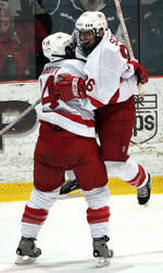






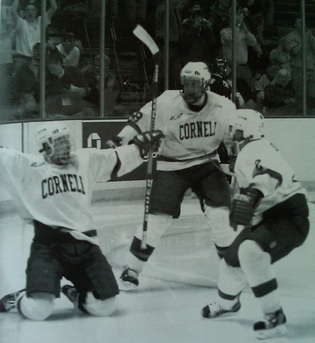
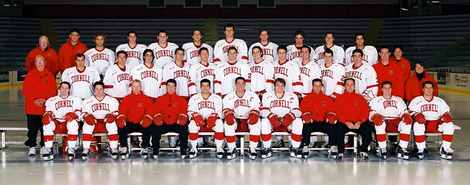





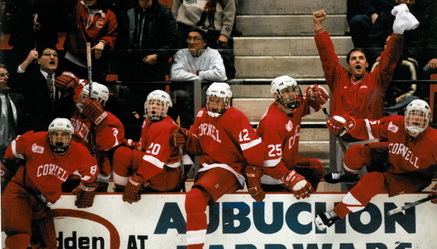
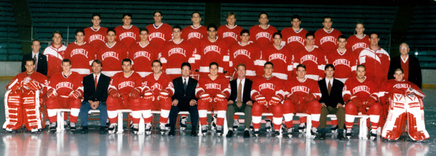





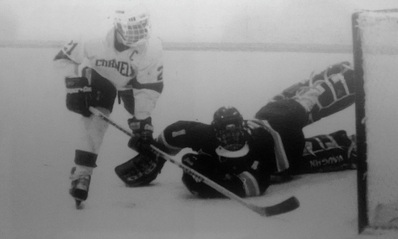
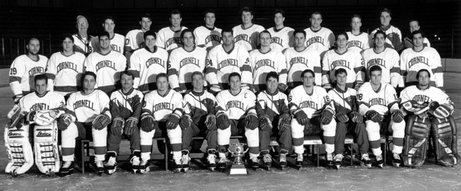





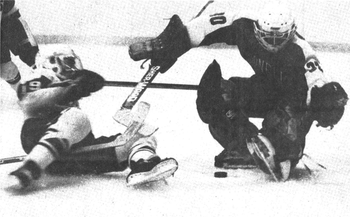
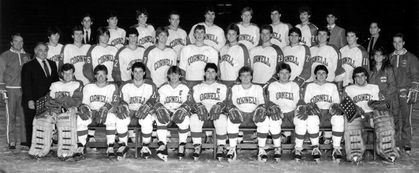






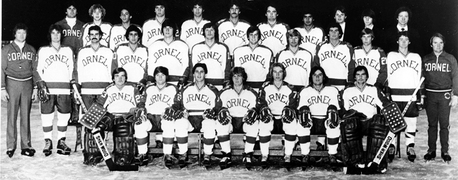





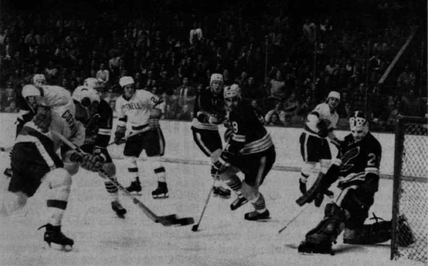
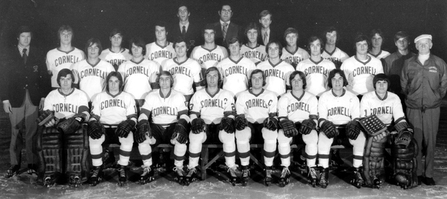





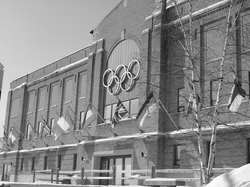
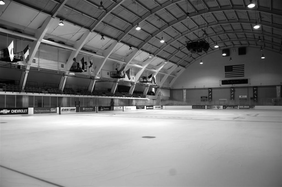
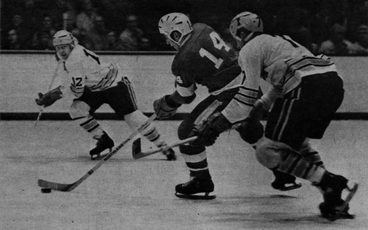
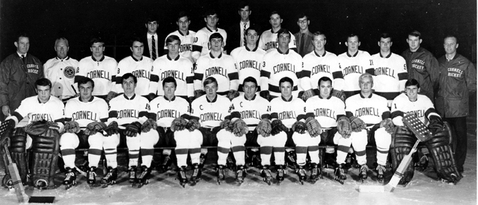





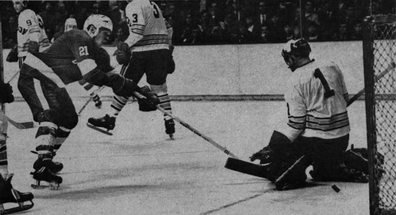
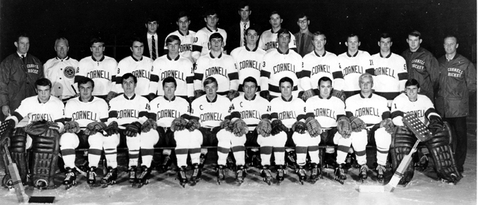





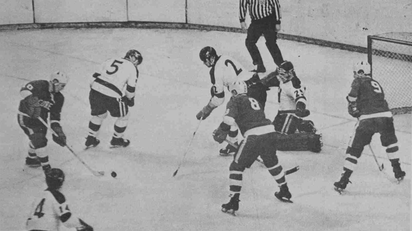
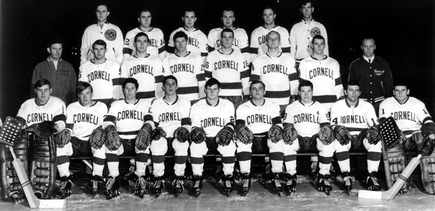


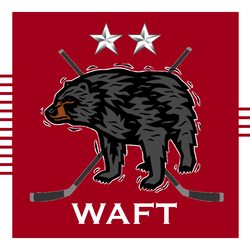

 RSS Feed
RSS Feed
